Guerrilla Girls
| Motto | Reinventing the "F" word: feminism! |
|---|---|
| Formation | 1985 |
| Headquarters | New York, New York, United States |
Region served | Worldwide |
Official language | English |
| Website |
guerrillagirls |
Guerrilla Girls is an anonymous group of feminist, female artists devoted to fighting sexism and racism within the art world.[1] The group formed in New York City in 1985 with the mission of bringing gender and racial inequality into focus within the greater arts community. The group employs culture jamming in the form of posters, books, billboards, and public appearances to expose discrimination and corruption. To remain anonymous, members don gorilla masks and use pseudonyms that refer to deceased female artists. According to GG1, identities are concealed because issues matter more than individual identities, "[M]ainly, we wanted the focus to be on the issues, not on our personalities or our own work."[2]
History
In the spring of 1985, seven women launched the Guerrilla Girls in response to the Museum of Modern Art's exhibition "An International Survey of Recent Painting and Sculpture" [1984), whose roster of 165 artists included only 13 women.[3] Inaugurating MoMA's newly renovated and expanded building, this exhibition claimed to survey that era's most important painters and sculptors from 17 countries.[4] The proportion of artists of color was even smaller, and none of them were women.
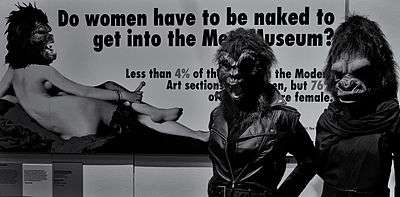
A comment by the show's curator, Kynaston McShine, further highlights that era's explicit art world gender bias: "Kynaston McShine gave interviews saying that any artist who wasn’t in the show should rethink ‘his’ career."[5] In reaction to the exhibition and McShine's overt bias, they protested in front of MoMA. Thus, the Guerrilla Girls were born.
When the protests yielded little success, the Guerrilla Girls wheat-pasted posters throughout downtown Manhattan, particularly in the SoHo and East Village neighborhoods.[6]
Soon after, the group expanded their focus to include racism in the art world, attracting artists of color. They also took on projects outside of New York, enabling them to address sexism and racism nationally and internationally. Though the art world has remained the group's main focus, the Guerrilla Girls' agenda has included sexism and racism in films, mass and popular culture, and politics. Tokenism also represents a major group concern.[6]
During its first years, the Guerrilla Girls conducted "weenie counts," such that members visited institutions like the Metropolitan Museum of Art and counted artworks' male-to-female subject ratios. Data gathered from the Met's public collections in 1989 showed that women artists had produced less than 5% of the works in the Modern Art Department, while 85% of the nudes were female.
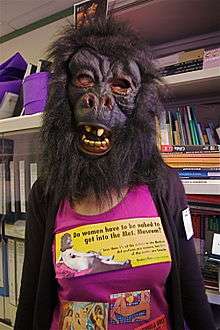
Early organizing was based around meetings, during which members evaluated statistical data gathered regarding gender inequality within the New York City's art scene. The Guerrilla Girls also worked closely with artists, encouraging them to speak to those within the community to bridge the gender gap where they perceived it.[7]
When asked about the masks, the girls answer "We were Guerrillas before we were Gorillas. From the beginning the press wanted publicity photos. We needed a disguise. No one remembers, for sure, how we got our fur, but one story is that at an early meeting, an original girl, a bad speller, wrote 'Gorilla' instead of 'Guerrilla.' It was an enlightened mistake. It gave us our 'mask-ulinity.'"[8] In an interview with New York Times the Guerrilla Girls were quoted, "Anonymous free speech is protected by the Constitution. You'd be surprised what comes out of your mouth when you wear a mask."[9]
Since 1985, the Guerrilla Girls have worked for an increased awareness of sexism and greater accountability on the part of curators, art dealers, collectors and critics.[10] The group is credited, above all, with sparking dialogue, and bringing national and international attention to issues of sexism and racism within the arts.
Influences
Many feminist artists in the 1970s dared to imagine that female artists could produce authentically and radically different art, undoing the prevailing visual paradigm. The pioneering feminist critic, Lucy Lippard curated an all-women exhibition in 1974, effectively protesting what most deemed a deeply flawed approach, that of merely assimilating women into the prevailing art system.[11] Shaped by the 1970s women’s movement, the Guerrilla Girls resolved to devise new strategies. Most noticeably, they realized that 1970s-era tools such as pickets and marches proved ineffective, as evidenced by how easily MoMA could ignore 200 protestors from the Women’s Caucus for Art. "We had to have a new image and a new kind of language to appeal to a younger generation of women," recalls one of the founding Guerrilla Girls, who goes by “Liubov Popova.”[12] The Guerrilla Girls sought an alternative approach, one that would defeat views of the 1970s Feminist movements as man-hating, anti-maternal, strident, and humorless:[11] Versed in poststructuralist theories, they adopted 1970s initiatives, but with a different language and style. Earlier feminists tackled grim and unfunny issues such as sexual violence, inspiring the Guerrilla Girls to keep their spirits intact by approaching their work with wit and laughter, thus preventing a backlash.[11]
Work: actions, posters and billboards
Art world
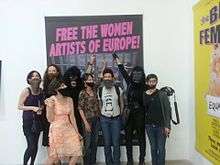
Throughout their existence, the Guerrilla Girls have gained the most attention for their bold protest art.[13] The Guerrilla Girls' projects (mostly posters at first) express observations, concerns, and ideals regarding numerous social topics. Their art has always been fact-driven, and informed by the group's unique approach to data collection, such as "weenie counts." To be more inclusive and to make their posters more eye-catching, the Guerrilla Girls tend to pair facts with humorous images.[14] Although the Guerrilla Girls gained fame for wheat-pasting provocative campaign posters around New York City, the group has also enjoyed public commissions and indoor exhibitions. They are no different than their ground-breaking street artist peers such as Robbie Conal, Jenny Holzer and Keith Haring.
In addition to posting posters around downtown Manhattan, they passed out thousands of small handbills based on their designs at various events.[7] The first posters were mainly black and white fact-sheets, highlighting inequalities between male and female artists with regard to number of exhibitions, gallery representation and pay. Their posters revealed how sexist the art world was in comparison to other industries and to national averages. For example, in 1985 they printed a poster showing that the salary gap in the art world between men and women was starker than the United States average, proclaiming "Women in America earn only 2/3 of what men do. Women artists earn only 1/3 of what men do." These early posters often targeted specific galleries and artists. Another 1985 poster listed the names of some of the most famous working artists, such as Bruce Nauman and Richard Serra. The poster asked "What do these artists have in common?" with the answer "They allow their work to be shown in galleries that show no more than 10% of women or none at all."
The group were also activists for equal representation of women in institutional art, and highlighted artist Louise Bourgeois in their "Advantages to Being a Women artist," poster in 1988 as one line read, "Knowing your career might not pick up till after you're 80."[15] Their pieces are also notable for their use of combative statements such as "When racism and sexism are no longer fashionable, what will your art collection be worth?"[6]
The posters were rude; they named names and they printed statistics (and almost always cited the source of those statistics at the bottom, making them difficult to dismiss). They embarrassed people. In other words, they worked.[16]
The Guerrilla Girls' first color poster, which remains the group's most iconic image, is the 1989 Metropolitan Museum poster, which used data from the group's first "weenie count." In response to the overwhelming amount of female nudes counted in the Modern Art sections, the poster asks, sarcastically, "Do women have to be naked to get into the Met. Museum?". Next to the text is an image of the Jean Auguste Dominique Ingres painting La Grande Odalisque, one of the most famous female nudes in Western art history, with a gorilla head placed over the original face.
In 1990, the group designed a billboard featuring the Mona Lisa that was placed along the West Side Highway supported by the New York City public art fund. For one day, New York's MTA Bus Company also displayed bus advertisements with Met. Museum poster. Stickers also became popular calling cards representative of the group.
The Guerrilla Girls infiltrated the bathrooms of the newly opened Guggenheim Soho, placing stickers regarding female inequality on the walls.[7] In 1998, Guerrilla Girls West protested at the San Jose Museum of Art, over low representation of women artists.[17]
In addition to researching and exposing sexism in the art world, the Guerrilla Girls have received commissions from numerous organizations and institutions, such as The Nation (2001),[18] Fundación Bilbao Arte (2002), Istanbul Modern (2006) and Witte de With Center for Contemporary Art (2007). They have also partnered with Amnesty International, contributing pieces to a show under the organization's "Protect the Human" initiative.[19]
Public commissions
In 2005, the group exhibited large-format posters Welcome to the Feminist Biennale at the Venice Biennale (the first in 110 years to be overseen by women), scrutinizing 101 years of Biennale history in terms of diversity. Where Are the Women Artists of Venice? explored the fact that most works owned by Venice's historical museums are kept in storage.[20][21][22]
Since 2005, the Guerrilla Girls have been invited to produce special projects for international institutions, sometimes for the very institutions they have criticized. Offers that pose a dilemma are carefully considered, so as to avoid censure, since one way to improve institutions is to criticize them from inside.[23]
Their 2006 poster The Future For Turkish Women Artists as Revealed by the Guerrilla Girls, commissioned by Istanbul Modern, demonstrated that the status of women artists in Turkey was better than in Europe.[24] In 2007, the Washington Post published their Horror on the National Mall!, a one-page newspaper spread attacking the absence of diversity among tax-payer supported museums on the Mall in Washington, DC.[25] During the 2007 ART-ATHINA, the Guerrilla Girls projected "Dear Art Collector" in Greek onto the entrance's façade. In 2015, they projected their "Dear Art Collector" animation onto a museum façade, taking on collectors who fail to pay employees a living wage.[26] To commemorate the 20th Anniversary of the École Polytechnique massacre, the University of Quebec commissioned their Troubler Le Repos (Disturbing The Peace) poster, whose texts addressed anti-women hate-speech since Ancient Greece to Rush Limbaugh.
In 2009, they launched I’m not a feminist, but If I were this is what I’d complain about…, an interactive graffiti wall that enables women who don't see themselves as feminists the means to target gender issues with the hope that active participation will broaden their perspectives.[27] In 2012, this traveled to Krakòw's Art Boom Festival.[28]
In 2012, an advertising truck towed Do women Have To Be Naked To Get Into Boston Museums? around Boston.[29] Invited by Yoko Ono to participate in the 2013 Meltdown Festival, the Guerrilla Girls updated their 2003 Estrogen Bomb poster, which had premiered in The Village Voice in 2003.
During Winter 2016, they participated in "Twin City Takeover," art exhibitions and art projects organized by a consortium of local art organizations sited around Minneapolis and St. Paul.[30][31] [32] [33][34]
Film world
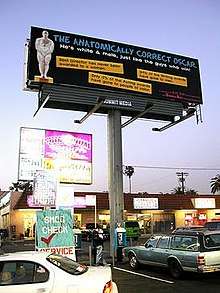
To protest the dearth of female directors, the Guerrilla Girls distributed stickers during the 2001 Sundance Film Festival.[35] The Nation invited them to present Birth of Feminism,[18] which they updated and presented in 2007 as a banner outside Witte de With Center for Contemporary Arts. Since 2002, Guerrilla Girls Inc. have designed and installed billboards during the Oscars that address white male dominance in the film industry, such as: "Anatomically Correct Oscars," "Even the Senate is More Progressive than Hollywood," "The Birth of Feminism,"[36] "Unchain the Women Directors."[37]
During the 2015 Reykjavik Arts Festival, the Guerrilla Girls displayed National Film Quiz, a billboard criticizing the fact that 87% of national funding for films goes to men, despite women playing an important part of Iceland's public and private sectors.[38] In light of 2016's #Oscarssowhite campaign, the Guerrilla Girls updated the above billboards, presenting them on downtown Minneapolis streets for "Twin City Takeover."[39]
Politics and social issues
Although the Guerrilla Girls' protest art directed at the art world remains their most well-known work, throughout their existence the group has periodically targeted politicians, specifically conservative Republicans. Those criticized have included George Bush, Newt Gingrich, and most recently Michele Bachmann. In 1991, the Artist and Homeless Collaborative invited them to work with homeless women to create posters in response to homelessness and the first Gulf War. Between 1992 and 1994, Guerrilla Girl posters addressed the 1992 Presidential election, reproductive rights (done for march on Washington in 1992), gay and lesbian rights, and the LA riots. During the 2012 election, they displayed their Even Michele Bachman believes…. on a billboard adjacent a football stadium to advertise her plan to: ban same-sex marriages, require Voter Id Checks, and spend money implementing statewide voter IDs.[40] Their 2013 posters discussed the Homeland Terror Alert system and Arnold Schwarzenegger’s gubernatorial campaign.
In 2016, the Guerrilla Girls launched the "President Trump Announces New Commemorative Months" campaign in the form of stickers and posters, which they distributed during the "Women's March on Washington" in LA and NYC, as well as the J20 event at the Whitney Museum of Art[41] and the Fire Fink protest at MoMA.[42]
Work: publications and merchandise
To shed light on inequality in the art world, the Guerrilla Girls have published numerous books. In 1995, they published their first book, Confessions of the Guerrilla Girls, a compilation of 50 works plus a self-interview.[43][44] In 1998, they published The Guerrilla Girls Bedside Companion to the History of Western Art, a consciousness-raising comic book that sold 82,000 copies, as it explores how art history's male domination constrained several female artists' careers.[45] In 2003, they published Bitches, Bimbos and Ballbreakers, a down and dirty catalogue of "The Top Stereotypes from Cradle to Grave." Offering thumbnail histories for cultural clichés ranging from "Daddy's Girl," "the Girl Next Door," "the Bimbo/Dumb Blonde" to "the Bitch /Ballbreaker", each is given "trademark Guerrilla Girl treatment: pointed factoids and cool graphics."[46][47]
Their 2004 book The Guerrilla Girl’s Museum Activity Book (reissued in 2012) parodies children's museum activity books. Meant to teach children how to both appreciate and critique museums, this book provides activities that reveal the problematic aspects of museum culture and major museum collections. In 2009, they published a history of hysteria, The Hysterical Herstory Of Hysteria And How It Was Cured From Ancient Times Until Now.[48] MFC-Michèle Didier reprinted it in 2011 and 2016.
Presentations
An important part of Guerrilla Girls’ outreach since 1985 has been presentations and workshops at colleges, universities, art organizations and sometimes at museums. The presentations, known as “gigs”, attract hundreds and sometimes thousands of attendees. In the gig, they play music, videos, show slides and talk about the history of their work, how it has evolved. At the end the GGs interact with audience members. New work is always included and gig material changes all the time. They have done hundreds of these events and have travelled to nearly every state as well as Europe, South America and Australia.
In recognition of their work, the Guerrilla Girls have been invited to give talks at world-renowned museums, including a presentation at the MoMA's 2007 "Feminist Futures" Symposium. They have also been invited to speak at art schools and universities across the globe, and gave a 2010 commencement speech at the School of the Art Institute of Chicago. To mark the 30th anniversary of the Guerrilla Girls, Matadero Madrid hosted "Guerrilla Girls: 1985-2015," an exhibition featuring most of the collective's production accompanied by a series of events including a talk/performance by Guerrilla Girl members Frida Kahlo and Käthe Kollwitz.[49][50] The exhibition also showed the 1992 documentary "Guerrilla in Our Midst" by Amy Harrison.[51] [52]
Three Guerrilla Girls appeared on the Stephen Colbert show on January 14, 2016.[53][54]
Exhibitions
Early solo exhibitions included: "The Night the Palladium Apologized" (1985), Palladium (New York City); "Guerrilla Girls Review the Whitney" (1987), Clocktower PS1; and "Guerrilla Girls" (1995), Printed Matter, Inc[55]
Career surveys include:
- "Guerrilla Girls Talk Back: The First Five Years, A Retrospective: 1985-1990" (1991), the Falkirk Cultural Center, San Rafael, California
- "The Guerrilla Girls" (2002), Fundacíon Bilbao Arte, Bilbao, ES
- "Guerrilla Girls" (2007), Hellenic American Union Galleries, Athens, GR
- "Guerilla Girls: Retrospective" (2009), Millennium Court Arts Centre, UK *"Feminist Masked Avengers: 30 Early Guerrilla Girls' Posters" (2011) Mason Gross School of the Arts Galleries
- "Not Ready to Make Nice: The Guerrilla Girls in the Art World and Beyond" (2012-2016)(traveled to Monserrat College of Art, Beverly, MA; Krannert Art Museum; Fairfield University; Georgia Museum of Art; De Pauw University; and Stony Brook University)
- "Guerrilla Girls: 1985-2013," Azkuna Zentroa (2013).
On the heels of "Not Ready to Make Nice" were:
- "Guerrilla Girls: Not Ready to Make Nice, 30 Years and Still Counting," 2015, Abrons Arts Center;[56]
- "Media Networks: Andy Warhol and the Guerrilla Girls," 2016, Tate Modern[57]
- "Art at the Center: Guerrilla Girls'," 2016, Walker Art Center[58]
- "The Guerrilla Girls and La Barbe", 2016, Gallery mfc-micheledidier, Paris.
- "Front Room: Guerilla Girls," 2016-2017, Baltimore Museum of Art
- "Not Ready to Make Nice: Guerilla Girls 1985-2016," 2016-2017, FRAC Lorraine.
- "Guerilla Girls", 2017, The Verge Center for the Arts, Sacramento, CA, U.S.A.
Controversies
Diversity
Despite having routinely challenged art institutions to display more artists of color, both members and critics want the Guerrilla Girls to be more diverse. Zora Neale Hurston recalls Guerrilla Girl membership as “mostly white” and largely mirroring the art world demographics that they critiqued.[59] Despite sporting gorilla masks to downplay personal identity, some members attribute Guerilla Girl interests to the fact that de facto leaders "Frida Kahlo" and "Kathe Kollwitz" are both white.[11] (“Frida Kahlo” has also been criticized for her appropriation of a Latina artist’s name.)[60] However, any precise information on the demographics of the Guerrilla Girls is impossible, for they have “staunchly, and problematically, resisted being surveyed as to the makeup of their own membership."[11]
Several Guerrilla Girls who are people of color have faced numerous challenges. Despite the Guerrilla Girls' stance against tokenism, some artists of color abandoned Guerrilla Girl membership due to tokenism, silencing, disrespect, and whitewashing.[11][59] As a woman of color, “Alma Thomas” describes having felt uncomfortable wearing the Guerrilla Girls’ signature gorilla mask.[61] "Thomas" recalls little effort being devoted to understanding the challenges of artists of color. “Their whiteness was such that they…. didn't understand that blacks were being put in a completely separate world in the art world, that black male artists and black female artists are completely separated, completely segregated to this day."[59] Ultimately, this widespread antagonism led to many “artists of color [leaving] after a few meetings because they could sense the unspoken hierarchy in the group."[62]
Second-wave feminism and essentialism

Emerging at the tail end of the second-wave feminist movement, the Guerrilla Girls navigated the differences between established and emerging feminist theory during the 1980s. “Alma Thomas” describes this grey-area that the Guerrilla Girls occupied as “universalist feminism,” bordering on essentialism.[61] Art Historian Anna Chave considers the Guerrilla Girls’ essentialism much more profound, leading the group to be “assailed by… a rising generation of women wise in the ways of poststructuralist theory, for [their] putative naiveté and susceptibility to essentialism."[11] Essentialist views are most clearly exhibited in two Guerrilla Girl books:The Guerrilla Girls Bedside Companion to the History of Western Art (1998) and the controversial Estrogen Bomb (2003–13) campaign. Regarding the former, “Alma Thomas” worried that The Guerrilla Girls Bedside Companion to the History of Western Art "was so embedded in that second-wave feminist and even pre-second-wave essentialism” that it fulfilled some assumption that all women artists are feminist artists.[61]
Students at Minneapolis College of Art and Design criticized their Estrogen Bomb poster campaign, describing it as insensitive towards transgender people since it ties the female gender to estrogen, the same sort of essentialist link the Guerilla Girls aim to critique.[63][64] Aside from essentialism, the Guerrilla Girls have also been critiqued for failing to integrate intersectionality into their work.[60] However, it is important to note that Guerrilla Girl beliefs are hardly monolithic, as individual members hold many different understandings of feminism.[61]
Internal disputes
Leading up to a highly publicized 2003 lawsuit, there was increasing animosity toward "Frida Kahlo" and "Käthe Kollwitz." Despite founding members' initial intention to create a non-hierarchal, equitable power structure, there was an increasing sense that two people were making "the final decisions no matter what you said."[59] Several Guerrilla Girls felt that their second book, The Guerrilla Girls Bedside Companion to the History of Western Art, primarily represented the views of “Kahlo” and “Kollwitz”. Some even felt that “Kahlo” and “Kollwitz” completely controlled the book, despite their having selected material created collectively by all Guerrilla Girls. There was even suspicion that these two not only claimed all the credit, but took all of the profits. Some members condemned the book as “undemocratic and… against the spirit of the [Guerrilla] Girls."[61]
As the Guerilla Girls gained in popularity, tensions led to what the Girls later called the "banana split," as five members actually split from the collective. Soon after several members stepped aside to form Guerrilla Girls Broadband, “Kahlo” and “Kollwitz” moved to trademark the name “Guerrilla Girls, Inc." to distinguish their realm from those of Guerrilla Girls BroadBand and Guerrilla Girls On Tour!, whose focus is discrimination in the theater world.[62] Even though their former colleague "Gertrude Stein" was in the on-tour group, "Kahlo" and "Kollwitz" charged them with copyright and trademark infringement and unjust enrichment. Many members of the group felt especially betrayed that "Kahlo" and "Kollwitz" had launched their lawsuit under their real names, Jerilea Zempel and Erika Rothenberg.[65]
This prompted negative reactions from both current and former Guerrilla Girls, who objected to “Kahlo” and “Kollwitz” claiming responsibility for having created the collective effort, as well as the flippancy with which they exchanged their anonymity for legal standing.[11]
Judge Louis L. Stanton, who handled the case, rejected the "bizarre" suggestion that defendants sporting gorilla masks be allowed to testify in his courtroom. He also stated that "Mundane court procedures for adjudicating legal rights and the ownership of property require direct and cross-examination of real persons with real addresses and attributes."[65]
In their forty-five page complaint, "Kahlo" and "Kollwitz" described themselves as the group's "guiding forces," even though the Guerrilla Girls were "informally organized, [and] had no official hierarchy." Initially, they asked the court to stop Guerrilla Girls Broadband from calling themselves Guerrilla Girls and sought millions of dollars in damages. In 2006, they settled with the theatre group who agreed to go by Guerrilla Girls on Tour.
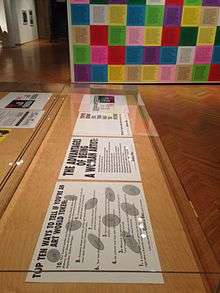
Selling-out
Upon their 1985 debut, the Guerrilla Girls were "lauded by the very establishment they sought to undermine." They have since exhibited at Tate Modern, Venice Biennale, Centre Pompidou, MoMA, which additionally grants them a broader audience for their concerns.[66] Since then, this relationship has only intensified, as the Guerrilla Girls presented their exhibitions in museums and even allowed their works to be collected by hegemonic institutions. Although some have questioned the efficacy, if not hypocrisy, of the group's working within the system that they originally denigrated, few would challenge their decision to let the Getty Institute house their archives.[60][66]
Members and names
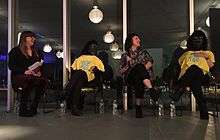
Membership in the New York City group is by invitation only, based on relationships with current and past members, and one's involvement in the contemporary art world. A mentoring program was formed within the group, pairing a new member with an experienced Guerrilla Girl to bring them into the fold. Due to the lack of formality, the group is comfortable with individuals outside of their base claiming to be Guerrilla Girls; Guerrilla Girl 1 stated in a 2007 interview: "It can only enhance us by having people of power who have been given credit for being a Girl, even if they were never a Girl." Men are not allowed to become Guerrilla Girls, but may support the group by assisting in promotional activities.[7]
Guerrilla Girls names are pseudonyms generally based on dead female artists. Members goes by names such as Kathe Kollwitz, Alma Thomas, Rosalba Carriera, Frida Kahlo, Alice Neel, Julia de Burgos, and Hannah Höch. Guerrilla Girls' "Carriera" is credited with the idea of using pseudonyms as a way to not forget female artists. Having read about Rosalba Carriera in a footnote of Letters on Cézanne by Rainer Maria Rilke, she decided to pay tribute to the little-known female artist with her name. This also helped to solve the problem of media interviews; the group was often interviewed by phone and would not give names, causing problems and confusion amongst the group and the media. Guerrilla Girl 1 joined in the late 1980s, taking on her name as a way to memorialize women in the art community who have fallen under the radar and did not make as notable as an impact as the names takes on by other members.[7]
Gorilla symbolism

The idea to adopt the gorilla as the group's symbol stemmed from a spelling error. One of the first Guerrilla Girls accidentally spelled the group's name at a meeting as "gorilla."[10] Despite the fact that the idea of using a gorilla as group symbol might have been accidental, the choice is nevertheless pertinent to the group's overall message in several key ways.
To begin with, the gorilla in popular culture and media is often associated with King Kong, or other images of trapped and tamed apes. In the 2010 SAIC Commencement, the comparison between institutionalized artists and tamed apes was explicitly made:
And last, but not least, be a great ape. In 1917, Franz Kafka wrote a short story titled A Report to An Academy, in which an ape spoke about what it was like to be taken into captivity by a bunch of educated, intellectual types. The published story ends with the ape tamed and broken by the stultified academics. But in an earlier draft, Kafka tells a different story. The ape ends his report by instructing other apes NOT to allow themselves to be tamed. He says instead: break the bars of your cages, bite a hole through them, squeeze through an opening…and ask yourself where do YOU want to go[67]
The gorilla is also typically associated with masculinity. The Met. Museum poster is in part shocking because of its juxtaposition of the eroticized female odalisque body, and the large, snarling gorilla head. The addition of the head detracts from the male gaze and changes the way in which viewers are able to look at or understand the highly sexualized image. Further, the addition of the gorilla questions and modifies stereotypical notions of female beauty within Western art and popular culture, another stated goal of the Guerrilla Girls.
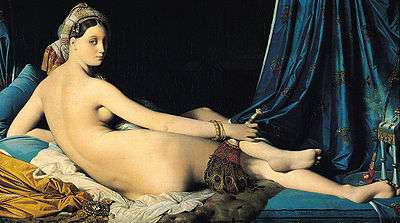
Guerrilla Girls, who wear the masks of big, hairy, powerful jungle creatures whose beauty is hardly conventional […] believe all animals, large and small, are beautiful in their own way.[68]
Though this goal has never been explicitly stated by the group, it is also helpful to note that in the history of Western art primates have often been associated with the visual arts, and with the figure of the artist. The idea of ars simia naturae ("art the ape of nature") maintains that the job of art is to "ape", or faithfully copy and represent nature. This was an idea first popularized by Renaissance thinker Giovanni Boccaccio who alleged that "the artist in imitating nature only follows Nature's own command."[69] The Guerrilla Girls' critique of art institutions mainly centers on the fact that there are fewer female subjects and artists represented in major art collections, a fact which is not at all reflective of the world's overall population. Ignoring women artists or artists of color cannot be seen as ars simia naturae, a fact that the ape image, whether intentionally or not, calls attention to.
Notable collections
- Art Institute of Chicago, Chicago, Illinois[70]
- Museum of Modern Art, New York, New York[6]
- Tate, United Kingdom[71]
- Walker Art Center, Minneapolis, Minnesota[72]
- Whitney Museum of American Art, New York, New York[73]
Notable exhibitions
- The Night the Palladium Apologized, 1985, Palladium, New York, New York
- Guerrilla Girls Review the Whitney, 1987, The Clocktower, New York, New York[7]
- Guerrilla Girls Printed Matter, 1995, 77 Wooster Street, SoHo[55]
- Guerrilla Girls: Exposición Retrospectiva, 2013, Alhóndiga Bilbao, Bilbao, Spain[52]
- Media Networks: Andy Warhol and the Guerrilla Girls, (display), 2016, Tate Modern, London, United Kingdom[57]
- Guerrilla Girls: Not Ready to Make Nice, 30 Years and Still Counting, Abron Arts Center, New York, New York[56]
- Art at the Center: Guerrilla Girls, 2016, Walker Art Center, Minneapolis, Minnesota[58]
Legacy
 Ridykeulous, The Advantages of Being a Woman Lesbian Artist, 2007.
Ridykeulous, The Advantages of Being a Woman Lesbian Artist, 2007.
See also
References
Notes
- ↑ Guerrilla Girls in Tate Modern Collection
- ↑ "Guerilla Girls Bare All". Archived from the original on 2014-01-13.
- ↑ MoMA Fact Sheet
- ↑ Brenson, Michael (April 21, 1984). "A Living Artists Show at the Modern Museum". The New York Times. Retrieved 27 February 2013.
- ↑ Guerrilla Girls (1995). Confessions of the Guerrilla Girls, with an essay by Whitney Chadwick. New York: Harper Perennial. p. 13. ISBN 9780060950880.
- 1 2 3 4 Ashton Cooper (2010). "Guerrilla Girls speak on social injustice, radical art". A&E. Columbia Spectator. Retrieved 20 April 2010.
- 1 2 3 4 5 6 Judith Olch Richards (2007). "Interview with Guerrilla Girls Rosalba Carriera and Guerrilla Girl 1". Archives of American Art. Retrieved 10 Jun 2011.
- ↑ "Interview". Guerrilla Girls. Archived from the original on 2014-01-13. Retrieved 2014-07-30.
- ↑ "Interview Magazine". Guerrilla Girls. Archived from the original on 2014-08-05. Retrieved 2014-07-30.
- 1 2 "Guerrilla Girls Bare All: An Interview". Guerrilla Girls. Archived from the original on 2014-01-13. Retrieved 2014-01-18.
- 1 2 3 4 5 6 7 8 Chave, Anna C. "The Guerrilla Girls' Reckoning." Art Journal 70.2 (2011): 102-11. Web.
- ↑ "Oral history interview with Guerrilla Girls Elizabeth Vigée LeBrun and Liubov Popova." January 19, 2008. Archives of American Art. Smithsonian Institution.
- ↑ "Brooklyn Museum: Guerrilla Girls". www.brooklynmuseum.org. Retrieved 2017-02-12.
- ↑ "We use facts, humor and outrageous visuals to expose sexism, racism and corruption in politics, art, film and pop culture."
- ↑ Louise Bourgeois; The Spider, The Mistress & The Tangerine. Directed by Marian Cajori and Amei Wallach. 2008. New York, NY: Zeitgeist Films, 2009. DVD
- ↑ Tallman, Susan (1991). "Guerrilla Girls" (PDF). Arts Magazine. 65 (8): 21–2. Archived from the original (PDF) on 2 July 2013. Retrieved 27 February 2013.
- ↑ "Masking for Art". Metro. April 29, 1998.
- 1 2 https://www.thenation.com/issue/april-2-2001/
- ↑ "Press releases in 2014". Amnesty International UK. Archived from the original on 2012-02-13. Retrieved 2014-01-18.
- ↑ Robinson, Walter. "Festive Venice". Artnet. Retrieved 27 February 2013.
- ↑ "Girl Power." The Economist. June 2, 2005
- ↑ Carol Vogel. "Subdued Biennale forgoes shock factor." The New York Times. June 13, 2005
- ↑ "Guerrilla Girl Gig," SUNY Stony Brook, NY, October, 2016
- ↑ http://vis129f.wikifoundry.com/page/Guerrilla+Girls%3A+“The+Future+for+Turkish+Women+Artists”-+Nicole+Young
- ↑ https://www.washingtonpost.com/wp-srv/artsandliving/museums/features/2007/feminism-and-art/guerrilla_girls.html
- ↑ http://www.artinamericamagazine.com/news-features/news/your-art-fair-antidote-the-guerrilla-girls-turn-30/
- ↑ http://www.nwci.ie/?/news/article/guerrilla_girls_take_on_irish_arts_exclusion_of_women
- ↑ http://www.huffingtonpost.co.uk/julian-vigo/guerrilla-girls-plant-a-b_b_3462596.html
- ↑ https://www.bostonglobe.com/arts/theater-art/2012/09/22/guerrilla-girls-launch-art-protest-targeting-museum-fine-arts/953Q0IyP3H9WxrWIcUhXUJ/story.html
- ↑ https://wedompls.org/urban-projects/guerrilla-girls/
- ↑ http://www.walkerart.org/magazine/2015/guerrilla-girls-30th-anniversary
- ↑ http://www.dazeddigital.com/artsandculture/article/29427/1/guerrilla-girls-giving-the-art-world-hell-since-85
- ↑ http://nytlive.nytimes.com/womenintheworld/2016/01/13/art-activists-guerrilla-girls-take-over-the-twin-cities/
- ↑ http://www.vogue.com/13390007/guerrilla-girls-twin-cities-takeover/
- ↑ https://www.thenation.com/article/west-indies/
- ↑ Archived March 25, 2012, at the Wayback Machine.
- ↑ "» Guerrilla Girls vs. King Kong". Art-for-a-change.com. 2006-02-05. Retrieved 2014-01-18.
- ↑ http://grapevine.is/culture/movies-theatre/2015/06/24/the-boys-club-men-are-strong-and-carry-around-big-cameras/
- ↑ http://www.guerrillagirls.com/exhibitions/
- ↑ http://articles.latimes.com/2012/oct/19/entertainment/la-et-cm-guerrilla-girls-use-twist-to-make-bachmann-a-gay-marriage-booster-20121019
- ↑ http://www.artnews.com/2017/01/20/speak-out-on-inauguration-day-words-at-the-whitney-museum-take-aim-at-trump/
- ↑ https://hyperallergic.com/360236/protesters-demand-moma-drop-trump-advisor-from-its-board/
- ↑ https://www.amazon.com/Confessions-Guerrilla-Girls-Guerilla/dp/0060950889
- ↑ Mark Dery. "Art Attack." The New York Times Book Review. July 30, 1995
- ↑ https://www.amazon.com/Guerrilla-Bedside-Companion-History-Western/dp/014025997X
- ↑ Hoban, Phoebe (January 4, 2004). "Masks Still in Place but Firmly in the Mainstream", The New York Times.
- ↑ https://www.motherjones.com/media/2004/01/bitches-bimbos-and-ballbreakers
- ↑ "Books by the Guerrilla Girls". Guerrilla Girls. Retrieved 2016-12-29.
- ↑ "Guerrilla Girls 1985-2015". MataderoMadrid. Retrieved 2016-03-05.
- ↑ "GUERRILLA GIRLS CONFERENCIA / PERFORMANCE". Vimeo. Retrieved 2016-03-05.
- ↑ "Guerrillas In Our Midst". guerrillasinourmidst.com. Retrieved 2016-03-05.
- 1 2 "GUERRILLA GIRLS. Exposición retrospectiva | Bilbao International". www.bilbaointernational.com. Retrieved 2016-05-24.
- ↑ "Guerrilla Girls Talk The History Of Art vs. The History Of Power". youtube.com. The Late Show with Stephen Colbert. January 14, 2016.
- ↑ Miller, M.H. (January 14, 2016). "Here Are the Guerrilla Girls on 'The Late Show with Stephen Colbert'". Artnews. Retrieved May 20, 2017.
- 1 2 Holland Cotter (February 10, 1995). "Art in Review". The New York Times.
- 1 2 New York Times August 9, 2015
- 1 2 "Andy Warhol and the Guerrilla Girls | Tate". www.tate.org.uk. Retrieved 2016-05-24.
- 1 2 "Art at the Center: Guerrilla Girls — Calendar — Walker Art Center". www.walkerart.org. Retrieved 2016-05-24.
- 1 2 3 4 Richards, Judith Olch; Hurston, Zora Neale; Martin, Agnes (2008-05-17). "Oral history interview with Guerrilla Girls Zora Neale Hurston and Agnes Martin, 2008 May 17 - Oral Histories | Archives of American Art, Smithsonian Institution". www.aaa.si.edu. Retrieved 2016-06-07.
- 1 2 3 Lodu, Mary (March 2016). "No No's: Guerrilla Girls at the State Theatre". INREVIEW.
- 1 2 3 4 5 Richards, Judith Olch; Bowles, Jane; Thomas, Alma (2008-05-08). "Oral history interview with Guerrilla Girls Jane Bowles and Alma Thomas, 2008 May 8 - Oral Histories | Archives of American Art, Smithsonian Institution". www.aaa.si.edu. Retrieved 2016-06-07.
- 1 2 Stein, Gertrude (Summer 2011). "Guerrilla Girls and Guerrilla Girls BroadBand: Inside Story". Art Journal. JSTOR 41430727.
- ↑ Cherneff, Lila, 2015-12-28, "Guerrilla Girls Stumble at MCAD," Radio Program, https://soundcloud.com/minneculture/guerrilla-girls-stumble-at-mcad, 2016-05-31, KFAI
- ↑ Jones, Hannah (2016-04-20). "The Guerrilla Girls, 'estrogen bombs' and exclusionary feminism". Twin Cities Daily Planet. Adaobi Okolue. Retrieved 2016-06-07.
- 1 2 Jeffrey Toobin. "Girls Behaving Badly."New Yorker. May 30, 2005.
- 1 2 Adams, Guy (2009-04-08). "Guerrilla girl power: Have America's feminist artists sold out?". The Independent. Independent Print Limited. Retrieved 2016-06-07.
- ↑ "School of the Art Institute of Chicago Commencement Address" (PDF). Guerrillagirls.com. May 22, 2010. Archived from the original (PDF) on October 5, 2013. Retrieved 2014-01-18.
- ↑ Girls, Guerrilla (2003). Bitches, Bimbos, and Ballbreakers: The Guerrilla Girls' Illustrated Guide to Female Stereotypes'. London: Penguin. ISBN 978-0-14-200101-1.
- ↑ Jason, H.W. (1952). Apes and Ape Lore in the Renaissance and Middle Ages. London: The Warburg Institute, University of London. p. 291.
- ↑ Art Institute of Chicago
- ↑ "Guerrilla Girls". Collections. Tate. Retrieved 25 September 2011.
- ↑ "11 Posters Celebrating 30 Years of the Guerrilla Girls — Magazine — Walker Art Center". www.walkerart.org. Retrieved 2016-04-12.
- ↑ Ryzik, Melena (2015-08-05). "The Guerrilla Girls, After 3 Decades, Still Rattling Art World Cages". The New York Times. ISSN 0362-4331. Retrieved 2016-05-23.
Bibliography
- Boucher, Melanie. Guerrilla Girls: Disturbing the Peace. Montreal: Galerie de l'UQAM, 2010. ISBN 2-920325-32-9
- Brand, Peg. "Feminist Art Epistemologies: Understanding Feminist Art." Hypatia. 3 (2007): 166–89.
- Guerrilla Girls. Bitches, Bimbos, and Ballbreakers: The Guerrilla Girls' Illustrated Guide to Female Stereotypes. London: Penguin, 2003. ISBN 978-0-14-200101-1
- Guerrilla Girls. Confessions of the Guerrilla Girls, with an Essay by Whitney Chadwick. New York City: HarperCollins, 1995. ISBN 0-04-440947-8
- Guerrilla Girls. The Guerrilla Girls' Bedside Companion to the History of Western Art. London: Penguin, 1998. ISBN 978-0-14-025997-1
- Janson, HW. Apes and Ape-Lore in the Middle Ages and the Renaissance. London: Warburg Institute, University of London, 1952.
- Raidiza, Kristen. "An Interview with the Guerrilla Girls, Dyke Action Machine DAM!, and the Toxic Titties." NWSA Journal. 1 (2007): 39–48. <https://www.jstor.org/stable/431723>. Accessed 27.2.2013.
- Schechter, Joel. Satiric Impersonations: From Aristophanes to the Guerrilla Girls. Carbondale: Southern Illinois University Press, 1994. ISBN 978-0-8093-1868-1
External links
- Official website
- The Feminist Future: Guerrilla Girls a video from a talk presented at the Museum of Modern Art.
- Guerrilla Girls, Brooklyn Museum's Elizabeth A. Sackler Center for Feminist Art
- Guerilla Girls records, Getty Research Institute
- Complete Chronology of Guerrilla Projects since 1985